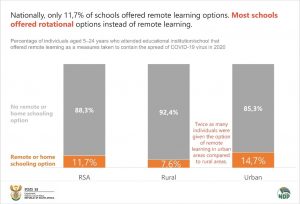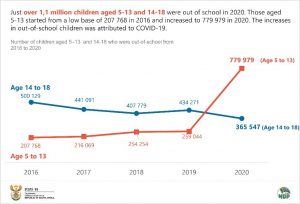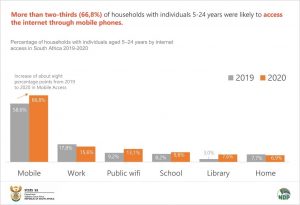How COVID-19 changed the way we learn.
Education is deemed to be a basic human right but, in 2020, the COVID-19 pandemic changed not only the way we live, but also the way we learn. First-time learners were destined to experience learning in a very different way than their predecessors. In South Africa, school closures were announced on 18 March 2020, interrupting the learning of almost 17 million learners from pre-school to secondary school. Close to 2,3 million students enrolled in post-school education and training institutions were affected by the implementation of the strict lockdown rules. New educational policies and regulations, including the adjustment of the academic time-table, new teaching programmes, mode of delivery, catch up of the curriculum, health and safety measures as well as financial relief packages were designed for the education sector.
While remote learning programmes were designed, this did not guarantee that the children participated in the instruction. According to a new report, “COVID-19 and barriers to participation in education in South Africa, 2020” released by Statistics South Africa, only 11,7% of schools offered remote learning options nationally. Most schools offered rotational options instead of remote learning and the urban-rural divide was prominent, as twice as many individuals were given the option of remote learning in urban areas compared to rural areas.
The 2020 lockdown regulations had a noticeable effect on the number of-out-school children in 2020. The disruptions created by the closures of schools and rotational attendance resulted in reduced levels of attendance. Close to one million children aged 5–18 were out-of-school. The largest number of out-of-school children was observed among children aged 5–13. The substantial increase in out-of-school children was attributed to the COVID-19 pandemic, because parents/caregivers did not want to expose their children to the virus and subsequently kept them at home. The other reason contributing to the dropout was that most educational facilities attended by children closed due to COVID-19. The highest percentage of non-attendance of schools was observed among 5- and 6-years olds (close to 38 and close 12 per cent respectively). The percentage of out-of-school children aged 5–13 was highest in the Western Cape (13,0%), followed by KwaZulu-Natal (9,1%).
An assessment of households’ readiness for remote learning in 2020 revealed a disparity in access to various resources necessary to participate in remote learning. Most households did not have digital assets such as laptops and tablets at home that would allow learners to learn remotely using digital tools. While cellphone ownership was high (91,3%) in 2020 among all households with children aged 5–24, computer ownership has remained relatively low (24,7%). Furthermore, seven out of ten (70,5%) children attending Grade 7 did not own mobile phones. In 2020, close to seven per cent of households with individuals aged 5–24 had access to the internet at home while most households accessed the internet via smart phones (66,8%). The workplace and the use of public wifi facilities were the other preferred modes of access to the internet by households with individuals aged 5–24 (15,6 and 13,1 per cent respectively).
A noticeable urban-rural divide (close to 19 percentage points) exists among these households in access to the internet using phones. Metropolitan households have greater connectivity from home compared to their rural counterparts (12 percentage points gap). In 2020 rural South African households made large gains in adopting internet connectivity via phones and have narrowed the access gaps (44,6% in 2019 compared to 56,8% in 2020). However, rural households remain less likely than urban households to have home internet connectivity when comparing 2019 to 2020.
While lockdowns were imposed in every country around the world, the key factor for keeping contact with the outside world is access to the internet and access to digital resources. Without these crucial tools, one was sure to be disadvantaged and somewhat left behind.
This report also covers difficulties encountered in the education sector during the onset of the 2020 lockdown following the COVID-19 pandemic as well as discusses policies initiatives, catch-up plans, and recovery strategies followed by government to mitigate the crisis. It presents the effect of the pandemic on early childhood education in the country and also covers deductions on how inequalities associated with access to digital connectivity of households have effects on access to quality distance learning.
For more information download the full report here.




